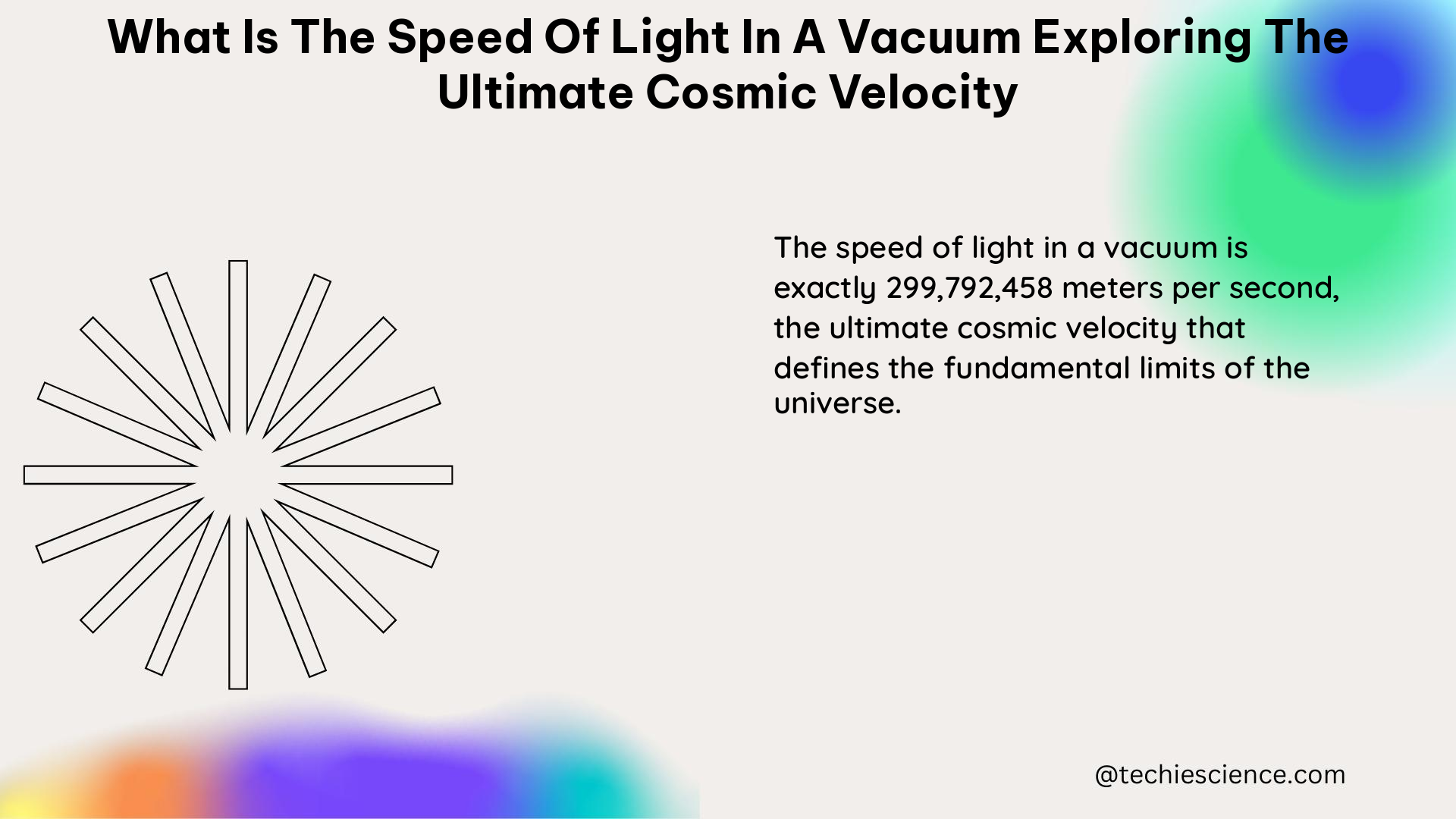The speed of light in a vacuum, denoted by the symbol c, is a fundamental constant in physics that represents the maximum possible speed at which all energy, matter, and information in the universe can travel. This cosmic velocity has been the subject of extensive research and experimentation, revealing a wealth of insights into the nature of our universe.
Theoretical Explanation
The speed of light in a vacuum is a direct consequence of the theory of special relativity, developed by Albert Einstein in the early 20th century. According to Einstein’s postulate, the speed of light is constant and independent of the motion of the source or observer. This constancy is a fundamental aspect of the structure of spacetime and has been extensively experimentally verified.
Technical Specification

- Value: The speed of light in a vacuum is exactly equal to 299,792,458 meters per second (m/s).
- Units: The speed of light is typically expressed in meters per second (m/s), but it can also be expressed in other units such as kilometers per second (km/s), where it is approximately 299,792.458 km/s.
- Precision: The current precision of the speed of light is extremely high, with an uncertainty of only ±0.000001 m/s.
Physics Formulae
Lorentz Transformation
The Lorentz transformation relates the space and time coordinates of an event in one inertial frame to those in another inertial frame. It is given by:
x' = γ (x - vt), t' = γ (t - vx/c^2)
where x and t are the space and time coordinates in the original frame, x' and t' are the coordinates in the new frame, v is the relative velocity between the frames, and γ is the Lorentz factor given by:
γ = 1/√(1 - v^2/c^2)
Time Dilation
Time dilation is a consequence of special relativity, where time appears to pass slower for an observer in motion relative to a stationary observer. It is given by:
t' = γ t
Length Contraction
Length contraction is another consequence of special relativity, where objects appear shorter to an observer in motion relative to a stationary observer. It is given by:
x' = x/γ
Examples and Numerical Problems
- Relative Velocity: If two objects are moving at 0.6c and 0.8c relative to each other, what is their relative velocity?
Solution: Use the relativistic velocity addition formula:
v_rel = (v1 + v2) / (1 + v1*v2/c^2) = (0.6c + 0.8c) / (1 + 0.6c*0.8c/c^2) = 0.946c
- Time Dilation: If a spaceship travels at 0.9c for 5 years, how much time will have passed on Earth?
Solution: Use the time dilation formula:
t_Earth = γ * t_spaceship = 1/√(1 - 0.9^2) * 5 years ≈ 11.18 years
Figures and Data Points
- Speed of Light Measurements: The speed of light has been measured with increasing accuracy over the years. Some notable measurements include:
- 1950: 299,792.5 ± 3.0 km/s (Louis Essen)
- 1972: 299,792,456.2 ± 1.1 m/s (US National Bureau of Standards)
Measurements and Values
- Cosmic Microwave Background (CMB) Dipole: The CMB dipole is a measure of the velocity of the Earth relative to the cosmic rest frame. It has been measured to be approximately 369.82 ± 0.11 km/s.
- Galaxy Surveys: The dipole in the distribution of galaxies around us is also related to our peculiar velocity. It has been detected in various surveys, including those of radio galaxies and quasars.
References
- Fast and Spurious: A Robust Determination of Our Peculiar Velocity with Future Galaxy Surveys – This paper explores an alternative method for measuring the observer velocity from the source number counts, using correlations between neighboring spherical harmonic coefficients.
- Do We Know Why There Is a Speed Limit in Our Universe? – This discussion on Stack Exchange provides an explanation for the speed limit in the universe, based on the mathematical consequences of certain physical constants and the principles of special relativity.
- The Cosmic Speed Limit – This article on ScienceBlogs discusses the speed of light as a universal limit and its implications for our understanding of space and time.
- Why No One Has Measured the Speed of Light – This Reddit discussion explores the concept of the speed of light and why it cannot be directly measured in one direction.
- Speed of Light – This Wikipedia article provides a comprehensive overview of the speed of light, including its definition, history of measurement, and theoretical significance.

The lambdageeks.com Core SME Team is a group of experienced subject matter experts from diverse scientific and technical fields including Physics, Chemistry, Technology,Electronics & Electrical Engineering, Automotive, Mechanical Engineering. Our team collaborates to create high-quality, well-researched articles on a wide range of science and technology topics for the lambdageeks.com website.
All Our Senior SME are having more than 7 Years of experience in the respective fields . They are either Working Industry Professionals or assocaited With different Universities. Refer Our Authors Page to get to know About our Core SMEs.